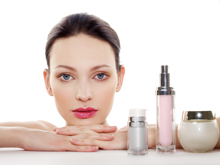Health Topics
-
Healthy Living
-
|
|
September 2011
|
| Ugly Side to Beauty Products |
| Dr. Radha Shah |
| |
 |
The use of beauty products is growing exponentially and the point of sales is not restricted to a doctor's clinic but ranges from medical shops, beauty salons and spas to shopping networks and Internet sites. Be it the international range of beauty products or the traditional home made remedies, people are using the same fervently with the assumption that they are absolutely harmless. |
However, just as the number of beauty products has increased, so has the number and types of side effects.These adverse reactions depend on the kind of product used, the way it was used and the type of skin of an individual.
To explain this,consider a moisturizer being used by a person with oily skin. Acneiform eruption (pimple like rash) results due to an already existing oily skin, if it is applied too frequently and also if the preparation contains lanolin or petrolatum, which causes occlusion and pimples.
The commonly encountered reactions to cosmetics include
- Contact dermatitis
- Pigmentation problems
- Acneiform eruptions
- Nail discolouration
- Onycholysis (separation of nail plate from nail bed)
- Fungal infection in nails
- Chronic paronychia (persistent swelling of the nail folds usually without pus)
- Generalized hairfall
- Contact dermatitis
- Folliculitis (pus filled infection around hair)
Contact dermatitis is the most common reaction, which can manifest itself immediately or after few days to upto after years of usage of a particular product. It can occur as a stinging sensation lasting more than few seconds, itching or burning sensation, hives (itchy, red raised, transient bumps like mosquito bites), or severely itchy red rashes which persist and get infected due to constant scratching. The products responsible are moisturizers, foundations, sunscreens, eyeliner, kajal, mascara, lipsticks, soaps, shaving creams, nail polish and its remover, hair dyes, shampoos and hair oils. The chemicals involved in producing these reactions include fragrances, lanolin, emulsifiers, chemical sunscreens, preservatives, propylene glycol, paraphenylene diamine (hair dye), methacrylates (sculptured nails), alcohols, lactic acid and balsam of Peru. Sometimes, contact reactions occur only if the area on which the cosmetic is applied is exposed to sunlight. This is seen with tars (medicated shampoos), psoralens and dyes (lipsticks), cinnamic acid (chemical sunscreens), optical bleaches and perfumes.
Pigmentation changes include hyper-pigmentation (darkening) with perfumes, eau de cologne and chronic use of cosmetics, which may be localized to area of contact or spread beyond due to spray preparations.It can be red and itchy initially but becomes a darker shade later. Lighter pigmentation can be observed on the use of bindis (phenols and catechols in adhesives).
Acneiform eruptions are seen with moisturizers, sunscreens and foundations and hair oils due to substances like lanolin, petrolatum, vegetable oils and lauryl alcohol. Pomade acne is seen in Negro population who use grease (pomade) on scalp to de-frizz their hair.
Nail discolouration is seen after dark shades of nail polish and nail hardeners. Chronic paronychia results due to cuticle removal during manicure and excess of nail polish removers.
Generalized hair fall is seen following use of harsh shampoos, hair colouring, perming and straightening as the hair shaft weakens and breaks easily.
Folliculitis (inflammation of hair follicles) on the body, especially of limbs occurs due to rubbing of thick, occlusive oils.
Diagnosis and Treatment
The above reactions are usually diagnosed by detailed patient history and patch testing to find the suspect chemicals. The treatment includes omission of suspect or proven cosmetic, topical steroids for contact reactions, anti acne creams like tretinoin for acneiform eruptions, bleaching cream like hydroquinone, glycolic acid for hyper-pigmentation. Alertness on the part of the user goes a long way in preventing side effects to cosmetics.
The household products causing side effects include
Besan - irritation,contact dermatitis
Milk products like cream and curd - acneiform rash
Lime juice - contact dermatitis, sun sensitivity
Oils like hair oil, eucalyptus, almond, olive - acneiform and folliculitis
Kumkum, kajal and bindi- contact dermatitis
Sandalwood paste - contact reactions, pigmentation
Multani mitti - contact dermatitis |
|
Tips to avert cosmetic reactions
- Frequent change of cosmetics should be avoided.
- Any new cosmetic, even if labeled 'For Sensitive Skin' should be first tested behind the ear or on forearm for ruling out any irritant potential.
- If a person is known allergic to a product, he must check the constituents of any new preparation and avoid those without any labeling.
- Know your skin type before choosing a product. Oily preparations should be avoided on oily or pimple prone skin.
- Pure henna can be used for hair dyeing in those allergic to permanent dyes.
- Avoid deodorant sprays; instead use sticks.
- Spray perfume on dress rather than direct contact with skin.
- Physical sunscreens or physical covering with protective clothing is the best option in those sensitive to chemical sunscreens.
- Always remember - what suits your friend or sibling may not suit you.
|
|
| |
Dr.Radha Shah Consultant Dermatologist Apollo Hospitals Hyderabad |
|
|